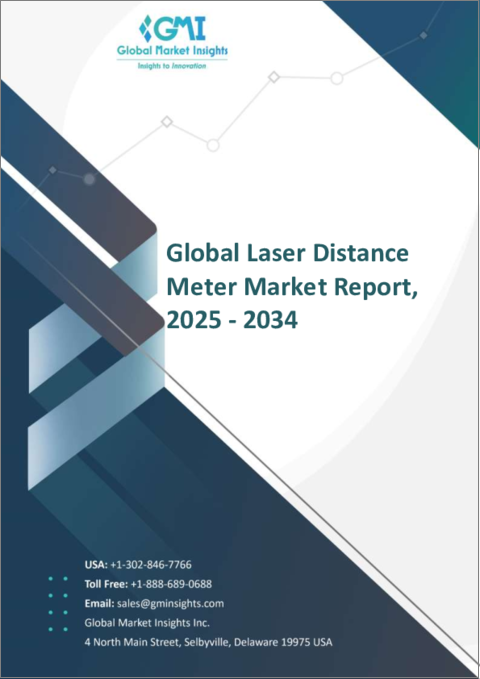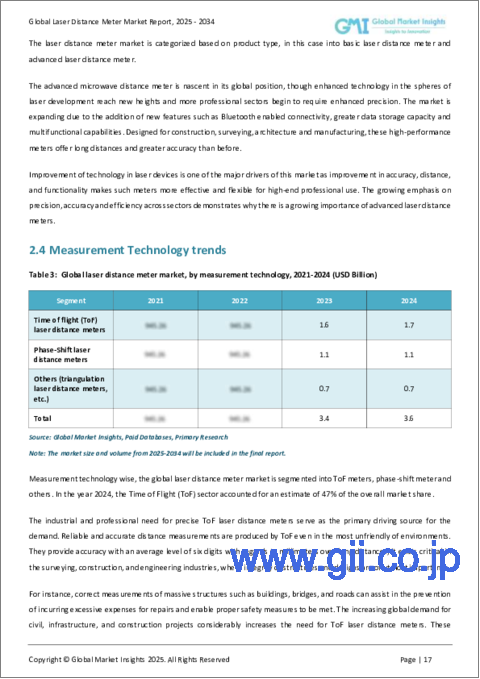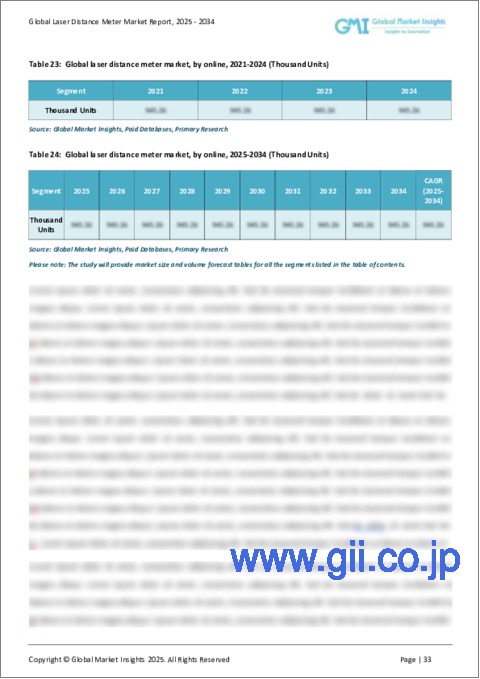|
|
市場調査レポート
商品コード
1639214
レーザー距離計市場の機会、成長促進要因、産業動向分析、2024年~2032年の予測Laser Distance Meter Market Opportunity, Growth Drivers, Industry Trend Analysis, and Forecast 2024 - 2032 |
||||||
カスタマイズ可能
|
|||||||
| レーザー距離計市場の機会、成長促進要因、産業動向分析、2024年~2032年の予測 |
|
出版日: 2024年11月20日
発行: Global Market Insights Inc.
ページ情報: 英文 220 Pages
納期: 2~3営業日
|
全表示
- 概要
- 目次
レーザー距離計の世界市場は、2023年に34億米ドルと評価され、2024年から2032年にかけてCAGR 6.5%で成長すると予測されています。
この成長は、主にこれらのデバイスの精度、範囲、および機能性を強化する継続的な技術進歩によってもたらされます。最新のレーザー距離計は、卓越した精度とBluetooth接続などの高度な機能を備えており、耐久性が高く、厳しい環境での使用に適しています。これらのデバイスは、ミリメートルレベルの精度を達成し、従来の機械的な測定ツールを大幅に凌駕します。この機能は、小さな誤差でも重大な問題を引き起こす可能性がある産業において特に価値があります。
オートメーションとデジタルツールの採用は、建設や不動産などのセクターを変革しています。レーザー距離計は、その使いやすさ、スピード、正確さにより、巻尺のような従来の測定ツールに取って代わりつつあります。時間が非常に重要な業界では、これらの機器を使用することで、専門家は従来の方法よりもはるかに速く測定を行うことができます。面積、材料の量、部屋の寸法を素早く評価できるため、全体的な効率が向上します。不動産業界では、エージェントや鑑定士が物件のサイズやスペースをより正確に判断し、より迅速で十分な情報に基づいた意思決定を行うのにも役立っています。
基本的なモデルは依然として安価だが、機能が強化されたプロ仕様のレーザー距離計は高価になる傾向があり、一部のユーザー、特に中小企業や新興市場のユーザーにとっては難題となっています。巻尺や光学式距離計のような従来型のツールは、特に小規模なプロジェクトではその手頃さから、特定の地域では依然として魅力を保っています。市場そのものは非常に細分化されており、多くのブランドが多様なモデルを提供しているため、消費者が適切なオプションを選択するのは困難です。さらに、新興市場の低価格・低品質製品の存在は、既存ブランドの価値を損なう価格競争を引き起こす可能性があります。
| 市場範囲 | |
|---|---|
| 開始年 | 2023 |
| 予測年 | 2024-2032 |
| 開始金額 | 34億米ドル |
| 予測金額 | 59億米ドル |
| CAGR | 6.5% |
製品タイプ別では、先進レーザ距離計セグメントは、2023年に22億6,000万米ドルで、2032年までCAGR 6.7%で成長すると予測されています。この成長の原動力となっているのは、レーザー計測技術の進歩と、専門分野における精度に対する需要の高まりです。Bluetooth接続やデータストレージなどの付加機能を備えたこれらのメータは、建設、測量、製造など、精度が最重要視される業界に最適です。
2023年にレーザー距離計市場で47%のシェアを占めた飛行時間(ToF)測定技術は、2024年から2032年にかけてCAGR 6.9%で成長すると予想されています。ToFメータは、厳しい条件下でも卓越した精度と信頼性を提供し、測量、建設、エンジニアリングのアプリケーションに特に有益です。これらのメータは、長距離にわたって正確な測定を保証し、正確な仕様が要求されるプロジェクトでコストのかかるエラーのリスクを低減するのに役立ちます。
米国では、レーザー距離計市場は2023年に7億2,000万米ドルを超え、2032年までCAGR 6.6%で成長すると予測されています。技術の進歩が建設や測量などの分野を形成し続けているため、先進的なレーザー距離計の需要が急増しています。これらのデバイスは、ますますデジタルシステムと統合され、ワークフローを最適化し、業界全体の測定精度を向上させています。
目次
第1章 調査手法と調査範囲
第2章 エグゼクティブサマリー
第3章 業界洞察
- エコシステム分析
- バリューチェーンに影響を与える要因
- 利益率分析
- 破壊
- 将来の展望
- メーカー
- 流通業者
- サプライヤーの状況
- 利益率分析
- 主要ニュース
- 規制状況
- 影響要因
- 促進要因
- 建設分野での自動化需要の増加
- 世界のインフラ開発と建設プロジェクトの増加
- 技術の進歩
- 業界の潜在的リスク&課題
- プレミアムモデルの初期コストの高さ
- 代替技術との競合
- 促進要因
- 成長可能性分析
- ポーター分析
- PESTEL分析
第4章 競合情勢
- イントロダクション
- 企業シェア分析
- 競合のポジショニング・マトリックス
- 戦略展望マトリックス
第5章 市場推計・予測:製品タイプ別、2021年~2032年
- 主要動向
- ハンドヘルド/標準レーザー距離計
- アドバンスト/プロフェッショナルグレードレーザー距離計
第6章 市場推計・予測:距離範囲別、2021年~2032年
- 主要動向
- 50メートル未満
- 50~200メートル
- 200メートル以上
第7章 市場推計・予測:測定技術別、2021~2032年
- 主要動向
- 飛行時間型(ToF)レーザー距離計
- フェーズシフトレーザー距離計
- その他(三角測量レーザー距離計など)
第8章 市場推計・予測:最終用途別、2021~2032年
- 建築・建設
- 製造・産業
- 鉱業
- 航空宇宙
- その他(農業、不動産など)
第9章 市場推計・予測:流通チャネル別、2021~2032年
- 主要動向
- オンライン
- オフライン
第10章 市場推計・予測:地域別、2021~2032年
- 主要動向
- 北米
- 米国
- カナダ
- 欧州
- 英国
- ドイツ
- フランス
- イタリア
- スペイン
- ロシア
- アジア太平洋
- 中国
- インド
- 日本
- 韓国
- オーストラリア
- ラテンアメリカ
- ブラジル
- メキシコ
- 中東・アフリカ
- UAE
- サウジアラビア
- 南アフリカ
第11章 企業プロファイル
- Agatec
- Bosch
- CEM Instruments
- Fluke
- Hilti
- Leica
- Makita
- Milwaukee
- Prexiso
- Sola Messwerkzeuge
- Spectra Precision
- Stabila
- Stanley Black & Decker, Inc.
The Global Laser Distance Meter Market was valued at USD 3.4 billion in 2023 and is projected to grow at a CAGR of 6.5% from 2024 to 2032. This growth is primarily driven by ongoing technological advancements that enhance the precision, range, and functionality of these devices. Modern laser distance meters offer exceptional accuracy and advanced features such as Bluetooth connectivity, making them highly durable and suitable for use in demanding environments. These devices achieve millimeter-level precision, significantly outperforming traditional mechanical measuring tools, a feature especially valuable in industries where even small errors can cause significant issues.
The adoption of automation and digital tools is transforming sectors like construction and real estate. Laser distance meters are increasingly replacing conventional measuring tools, such as tape measures, due to their ease of use, speed, and accuracy. In industries where time is critical, these devices allow professionals to perform measurements much faster than with traditional methods. They enable quick assessments of areas, material quantities, and room dimensions, improving overall efficiency. In real estate, they are also helping agents and appraisers determine property sizes and spaces more accurately, facilitating quicker and more informed decision-making.
While basic models remain inexpensive, professional-grade laser distance meters with enhanced features tend to be more expensive, posing a challenge for some users, particularly small businesses or those in emerging markets. Conventional tools like tape measures and optical rangefinders still hold appeal in certain regions due to their affordability, especially for smaller projects. The market itself is highly fragmented, with many brands offering diverse models, which can make it challenging for consumers to choose the right option. Additionally, the presence of lower-cost, low-quality products from emerging markets can drive price wars that undermine the value of established brands.
| Market Scope | |
|---|---|
| Start Year | 2023 |
| Forecast Year | 2024-2032 |
| Start Value | $3.4 Billion |
| Forecast Value | $5.9 Billion |
| CAGR | 6.5% |
In terms of product types, the advanced laser distance meter segment was valued at USD 2.26 billion in 2023 and is expected to grow at a CAGR of 6.7% through 2032. This growth is fueled by advancements in laser measurement technology and a rising demand for precision in professional fields. These meters, which feature added functionalities like Bluetooth connectivity and data storage, are ideal for industries such as construction, surveying, and manufacturing, where accuracy is paramount.
The time of flight (ToF) measurement technology, which held a 47% share of the laser distance meter market in 2023, is expected to grow at a CAGR of 6.9% from 2024 to 2032. ToF meters deliver exceptional accuracy and reliability, even in challenging conditions, and are particularly beneficial for applications in surveying, construction, and engineering. These meters help ensure precise measurements over long distances, reducing the risk of costly errors in projects that require exact specifications.
In the U.S., the laser distance meter market surpassed USD 720 million in 2023 and is set to grow at a CAGR of 6.6% through 2032. As technological advancements continue to shape sectors like construction and surveying, the demand for advanced laser distance meters has surged. These devices are increasingly integrated with digital systems, optimizing workflows and improving measurement accuracy across industries.
Table of Contents
Chapter 1 Methodology & Scope
- 1.1 Market scope & definitions
- 1.2 Base estimates & calculations
- 1.3 Forecast calculations
- 1.4 Data sources
- 1.4.1 Primary
- 1.4.2 Secondary
- 1.4.2.1 Paid sources
- 1.4.2.2 Public sources
Chapter 2 Executive Summary
- 2.1 Industry synopsis, 2021-2032
Chapter 3 Industry Insights
- 3.1 Industry ecosystem analysis
- 3.1.1 Factor affecting the value chain
- 3.1.2 Profit margin analysis
- 3.1.3 Disruptions
- 3.1.4 Future outlook
- 3.1.5 Manufacturers
- 3.1.6 Distributors
- 3.2 Supplier landscape
- 3.3 Profit margin analysis
- 3.4 Key news & initiatives
- 3.5 Regulatory landscape
- 3.6 Impact forces
- 3.6.1 Growth drivers
- 3.6.1.1 Increasing demand for automation in construction sector
- 3.6.1.2 Growth in infrastructure development and construction projects globally
- 3.6.1.3 Technological advancements
- 3.6.2 Industry pitfalls & challenges
- 3.6.2.1 High initial cost of premium models
- 3.6.2.2 Competition from alternative technologies
- 3.6.1 Growth drivers
- 3.7 Growth potential analysis
- 3.8 Porter's analysis
- 3.9 PESTEL analysis
Chapter 4 Competitive Landscape, 2023
- 4.1 Introduction
- 4.2 Company market share analysis
- 4.3 Competitive positioning matrix
- 4.4 Strategic outlook matrix
Chapter 5 Market Estimates & Forecast, By Product Type, 2021-2032 (USD Billion) (Thousand Units)
- 5.1 Key trends
- 5.2 Handheld/standard laser distance meter
- 5.3 Advanced/professional-grade laser distance meter
Chapter 6 Market Estimates & Forecast, By Distance Range, 2021-2032 (USD Billion) (Thousand Units)
- 6.1 Key trends
- 6.2 Up to 50 meters
- 6.3 50 to 200 meters
- 6.4 Above 200 meters
Chapter 7 Market Estimates & Forecast, By Measurement Technology, 2021-2032 (USD Billion) (Thousand Units)
- 7.1 Key trends
- 7.2 Time of flight (ToF) laser distance meters
- 7.3 Phase-Shift laser distance meters
- 7.4 Others (triangulation laser distance meters, etc.)
Chapter 8 Market Estimates & Forecast, By End Use, 2021-2032 (USD Billion) (Thousand Units)
- 8.1 Building & construction
- 8.2 Manufacturing & industrial
- 8.3 Mining
- 8.4 Aerospace
- 8.5 Others (agriculture, real estate, etc.)
Chapter 9 Market Estimates & Forecast, By Distribution Channel, 2021-2032 (USD Billion) (Thousand Units)
- 9.1 Key trends
- 9.2 Online
- 9.3 Offline
Chapter 10 Market Estimates & Forecast, By Region, 2021-2032 (USD Billion) (Thousand Units)
- 10.1 Key trends
- 10.2 North America
- 10.2.1 U.S.
- 10.2.2 Canada
- 10.3 Europe
- 10.3.1 UK
- 10.3.2 Germany
- 10.3.3 France
- 10.3.4 Italy
- 10.3.5 Spain
- 10.3.6 Russia
- 10.4 Asia Pacific
- 10.4.1 China
- 10.4.2 India
- 10.4.3 Japan
- 10.4.4 South Korea
- 10.4.5 Australia
- 10.5 Latin America
- 10.5.1 Brazil
- 10.5.2 Mexico
- 10.6 MEA
- 10.6.1 UAE
- 10.6.2 Saudi Arabia
- 10.6.3 South Africa
Chapter 11 Company Profiles
- 11.1 Agatec
- 11.2 Bosch
- 11.3 CEM Instruments
- 11.4 Fluke
- 11.5 Hilti
- 11.6 Leica
- 11.7 Makita
- 11.8 Milwaukee
- 11.9 Prexiso
- 11.10 Sola Messwerkzeuge
- 11.11 Spectra Precision
- 11.12 Stabila
- 11.13 Stanley Black & Decker, Inc.






